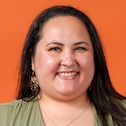The parents of the 10-year-old didn’t understand why there were cuts on their child’s arms.
It wasn’t until a routine physical that the child’s doctor, Sarah Polk, figured out the child had been self-harming out of fear their parents could get deported.
“[They] hadn’t wanted to upset anybody, hadn’t wanted to increase anybody’s stress, so hadn’t confided this fear in anybody else,” Polk said. “Cutting yourself is really a very profound sign of mental distress.”
The parents were able to talk to a professional about how to manage their child’s anxiety. But Polk, who works primarily with Latino children and immigrant families, worries that others aren’t getting the same mental and physical help. She has noticed more patients skipping doctors’ appointments as immigration enforcement picks up near their health center. Scared families are keeping low profiles at home, away from the eye of law enforcement.
Life for kids in immigrant families has changed under President Donald Trump’s second term. In ways that aren’t always visible to parents, they are dealing with increasing uncertainty and isolation as deportations ramp up. Polk said she also worries about the anti-immigrant rhetoric kids could be internalizing as they form their identities.
Since Trump reentered office, deportations have more than doubled in Maryland while increasingly targeting immigrants without criminal charges or convictions. At the same time, the federal government is trying to curtail access to programs like free early childhood centers, the child tax credit and extra instruction for students learning English — all of which impact the quality of life for kids in immigrant families.
Some of those kids could also soon lose access to Head Start, which provides free early childhood education for low-income families. The U.S. Department of Health and Human Services recently reclassified certain social services as “federal public benefits” to lock undocumented immigrants out, reversing decades of precedent. That includes Head Start.
The Trump administration has paused implementing the ban until Sept. 4 in 20 states that have sued over the policy change, including Maryland.
Some who work with Head Start said parents may pull their kids from classrooms even if their child is technically eligible but lives in a mixed-immigration status household. Head Start has never required a check on children’s immigration statuses, and some families, like those experiencing homelessness, may not have documentation. The ban could alter relationships between Head Start programs and already frightened communities.
Tommy Sheridan, the deputy director at the National Head Start Association, said investing in the program leads to more parents working, more children hitting their development milestones and fewer families relying on public assistance.
Read More
“Our priority is on the well-being, the safety for young children and their families,” Sheridan said. “And we’re concerned and, frankly, alarmed that this could threaten that.”
The head of the Maryland Family Network, the largest grantee of Early Head Start dollars in the state, said the change punishes children “who have no role in coming here or where they were born or what their parents did before they existed.”
“Turning away any child — and we’re talking about babies, toddlers, preschoolers here — from their opportunity to have a strong start in life and a prosperous future and a resilient family, is antithetical to what the supposed American dream is,” Laura Weeldreyer said.
Maryland Family Network oversees 16 Early Head Start centers for infants and toddlers, mostly in places where there’s already a shortage of child care options, Weeldreyer said. In Baltimore, regulated child care is only available to 20% of infants.
Weeldreyer fears that families will turn to unregulated care if they even suspect Head Start will turn away their child or that ICE, which can now make arrests at schools and day cares, might show up. Parents cobbling together care across family and neighbors, changing who their children are with each day, can be “stressful for babies,” she said.
Child care operators could lose revenue and staff when fear keeps immigrants home. In Maryland, 29% of early educators were born outside the U.S. Day care and preschool closures can drive up prices for all families, as they did after the pandemic.

Cuts could keep coming for kids beyond their earliest years. Federal funds dedicated to teaching English to students who speak other languages were part of the billions withheld from school systems that had already budgeted the cash.
Though the U.S. Department of Education has promised to restore this year’s congressionally appropriated funds, those earmarked for English learners are not in Trump’s budget for next fiscal year said Lina Lenis, a policy analyst for K-12 education for UnidosUS.
Lenis said the money helps those students get to a place where they no longer need the extra help. In Maryland, 11.2% of public school students are English learners, Lenis said.
“They start to fall behind in math and science because they can’t access their education meaningfully,” she said.
School resources could also be stretched by a “much greater number of children experiencing some degree of mental distress” said Polk, a co-director at Johns Hopkins’ Centro SOL for Latino families. While children are resilient, struggles with depression or anxiety could hurt kids’ performance in school or how they make friends. There’s a “small but real” risk of self-harm and suicide.
Polk said she worries about people “suffering in silence together,” with kids trying to put their parents first, like the 10-year-old worried about deportation.
“It’s really a tremendous act of generosity to remain silent, but it doesn’t help anybody,” Polk said. “Because the parents know that their child isn’t OK.”
About the Education Hub
This reporting is part of The Banner’s Education Hub, community-funded journalism that provides parents with resources they need to make decisions about how their children learn. Read more.




Comments
Welcome to The Banner's subscriber-only commenting community. Please review our community guidelines.